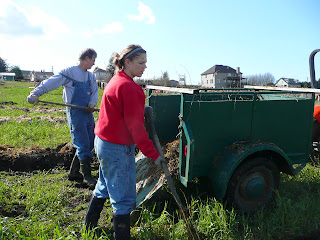
Updates on the chicks have been requested, so here it is. The ones we hatched are 3 weeks old now, (this picture was taken at 2 1/2 weeks) growing feathers, and establishing their pecking order. They graduated from the box in the living room to their own coop outside with a heat lamp. We ended up with 21 chicks from the 40 eggs we incubated, a result we were pleased with. We estimate that maybe 10 of them could be hens and the rest roosters, (we didn't even try to pretend we could sex them) so we supplemented the flock with 9 more Barred Rock chicks of similar age from the feed store. After introducing them slowly, they are now all together in the coop. The ones we hatched are a mix of Barred Rock and Rhode Island Red, and only two of them are yellow color, the rest are black. They are comical to watch when they get used to our presence. They square off beak to beak in some sort of show of toughness and then one decides they've had enough and wanders off. That is what they seem to do all day, wander, explore, jump and scratch, and every once in a while, they get a burst of energy and fly up as high as they can, seemingly just for the fun of it. They all seem healthy and content (can a chicken be happy?) at this point. Just wait until they get to see the outside world and scratch in some real dirt. Let the contented clucking sounds begin!











